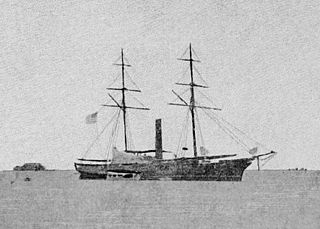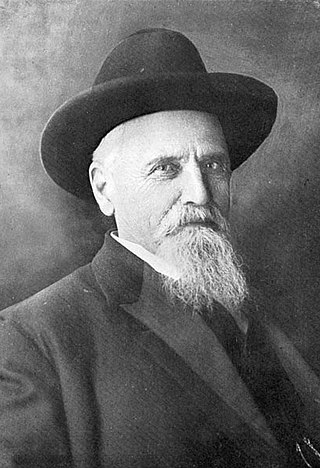Related Research Articles

USS Vincennes was a 703-ton Boston-class sloop of war in the United States Navy from 1826 to 1865. During her service, Vincennes patrolled the Pacific, explored the Antarctic, and blockaded the Confederate Gulf coast in the Civil War. Named for the Revolutionary War Battle of Vincennes, she was the first U.S. warship to circumnavigate the globe.

John Randolph Tucker, an American naval officer who served in the navies of three nations. He was a commander in the United States Navy, captain in the Confederate States Navy, and rear admiral in the Peruvian Navy. As president of the Peruvian Hydrographic Commission of the Amazon, he contributed to the exploration and mapping of the upper Amazon Basin.

The second USS Portsmouth was a wooden sloop-of-war in the United States Navy in service during the mid-to-late 19th century. She was designed by Josiah Barker on the lines of a French-built privateer, and built at the Portsmouth Navy Yard, directly across the Piscataqua River from Portsmouth, New Hampshire. She was described as an improvement over USS Saratoga built in the same shipyard a year earlier. Portsmouth was launched on 23 October 1843 and commissioned on 10 November 1844, with Commander John Berrien Montgomery in command.

The Knights of the Golden Circle (KGC) was a secret society founded in 1854 by American George W. L. Bickley, the objective of which was to create a new country, known as the Golden Circle, where slavery would be legal. The country would have been centered in Havana and would have consisted of the Southern United States and a "golden circle" of territories in Mexico, Central America, northern parts of South America, and Cuba, Haiti, Dominican Republic, and most other islands in the Caribbean, about 2,400 miles (3,900 km) in diameter.

The Pacific Squadron was part of the United States Navy squadron stationed in the Pacific Ocean in the 19th and early 20th centuries. Initially with no United States ports in the Pacific, they operated out of storeships which provided naval supplies and purchased food and obtained water from local ports of call in the Hawaiian Islands and towns on the Pacific Coast. Throughout the history of the Pacific Squadron, American ships fought against several enemies. Over one-half of the United States Navy would be sent to join the Pacific Squadron during the Mexican–American War. During the American Civil War, the squadron was reduced in size when its vessels were reassigned to Atlantic duty. When the Civil War was over, the squadron was reinforced again until being disbanded just after the turn of the 20th century.

The second USS Cyane was a sloop-of-war in the United States Navy during the Mexican–American War.

The first USS Saginaw was a sidewheel sloop-of-war in the United States Navy during the American Civil War. The ship was in operation throughout the 1860s, but in 1870 wrecked on what is now known as Kure Atoll, a Pacific island. The event produced several books and one of the surviving boats from the ship is in a museum.

The first USS Jamestown was a sloop-of-war in the United States Navy during the Mexican–American War and the American Civil War.

The Pacific Mail Steamship Company was founded April 18, 1848, as a joint stock company under the laws of the State of New York by a group of New York City merchants. Incorporators included William H. Aspinwall, Edwin Bartlett, Henry Chauncey, Mr. Alsop, G.G. Howland and S.S. Howland.

California's involvement in the American Civil War included sending gold east to support the war effort, recruiting volunteer combat units to replace regular U.S. Army units sent east, in the area west of the Rocky Mountains, maintaining and building numerous camps and fortifications, suppressing secessionist activity and securing the New Mexico Territory against the Confederacy. The State of California did not send its units east, but many citizens traveled east and joined the Union Army there, some of whom became famous.

The Pacific coast theater of the American Civil War consists of major military operations in the United States on the Pacific Ocean and in the states and Territories west of the Continental Divide. The theater was encompassed by the Department of the Pacific that included the states of California, Oregon, and Nevada, the territories of Washington, Utah, and later Idaho.
Edwin T. Woodward, was a naval officer during and after the American Civil War.

USS Vanderbilt was a heavy (3,360-ton) passenger steamship obtained by the Union Navy during the second year of the American Civil War and utilized as a cruiser.
The Confederate privateers were privately owned ships that were authorized by the government of the Confederate States of America to attack the shipping of the United States. Although the appeal was to profit by capturing merchant vessels and seizing their cargoes, the government was most interested in diverting the efforts of the Union Navy away from the blockade of Southern ports, and perhaps to encourage European intervention in the conflict.

Asbury Harpending was an adventurer and financier in San Francisco, California, Mexico, and New York City.
Hispanics in the American Civil War fought on both the Union and Confederate sides of the conflict. Not all the Hispanics who fought in the American Civil War were "Hispanic Americans" — in other words citizens of the United States. Many of them were Spanish subjects or nationals from countries in the Caribbean, Central and South America. Some were born in what later became a U.S. territory and therefore did not have the right to U.S. citizenship. It is estimated that approximately 3,500 Hispanics, mostly Mexican-Americans, Puerto Ricans and Cubans living in the United States joined the war: 2,500 for the Confederacy and 1,000 for the Union. This number increased to 10,000 by the end of the war.

The role of Washington Territory in the American Civil War is atypical, as the territory was the most remote from the main battlefields of the conflict. The territory raised a small number of volunteers for the Union Army, who did not fight against the Confederate States Army but instead maintained defensive positions against possible foreign naval or land attacks. Although the Indian Wars in Washington were recent, there were no Indian hostilities within the area of modern Washington, unlike the rest of the western states and territories, during the Civil War. At the start of the American Civil War, modern-day Washington was part of the Washington Territory. On March 3, 1863, the Idaho Territory was formed from that territory, consisting of the entirety of modern-day Idaho, Montana, and all but southwest Wyoming, leaving the modern-day Washington as Washington Territory.
Salvador Pirates was the name given to the band of Confederate Navy sailors that attempted to seize a Panama Railroad coastal steamer on the high seas. Their intent was then to arm her and attack the Pacific Mail steamers and the American whalers in the North Pacific.

Fort Alcatraz was a United States Army coastal fortification on Alcatraz Island near the mouth of San Francisco Bay in California, part of the Third System of fixed fortifications, although very different from most other Third System works. Initially completed in 1859, it was also used for mustering and training recruits and new units for the Civil War from 1861 and began secondary use as a long-term military prison in 1868.
References
- ↑ DANFS Online; Dictionary of American Naval Fighting Ships, Page 584, APPENDIX II. ANNEX I, PRIVATEERS COMMISSIONED BY THE CONFEDERATE STATES GOVERNMENT
- ↑ California Military Museum; The Pacific Squadron of 1861-1866, The following article is taken from Aurora Hunt's book, The Army of the Pacific; Its operations in California, Texas, Arizona, New Mexico, Utah, Nevada, Oregon, Washington, plains region, Mexico, etc. 1860-1866, under the chapter "The Pacific Squadron of 1861-1866", pp.305-310
- ↑ John Boessenecker, Badge and Buckshot: Lawlessness in Old California, University of Oklahoma Press, 1997. pg. 135-136
- ↑ Gaines, W. Craig (2008) Encyclopedia of Civil War shipwrecks. (LSU Press), p.28.
